Magic Stories for Kids: Spark Imagination and Teach Life Lessons
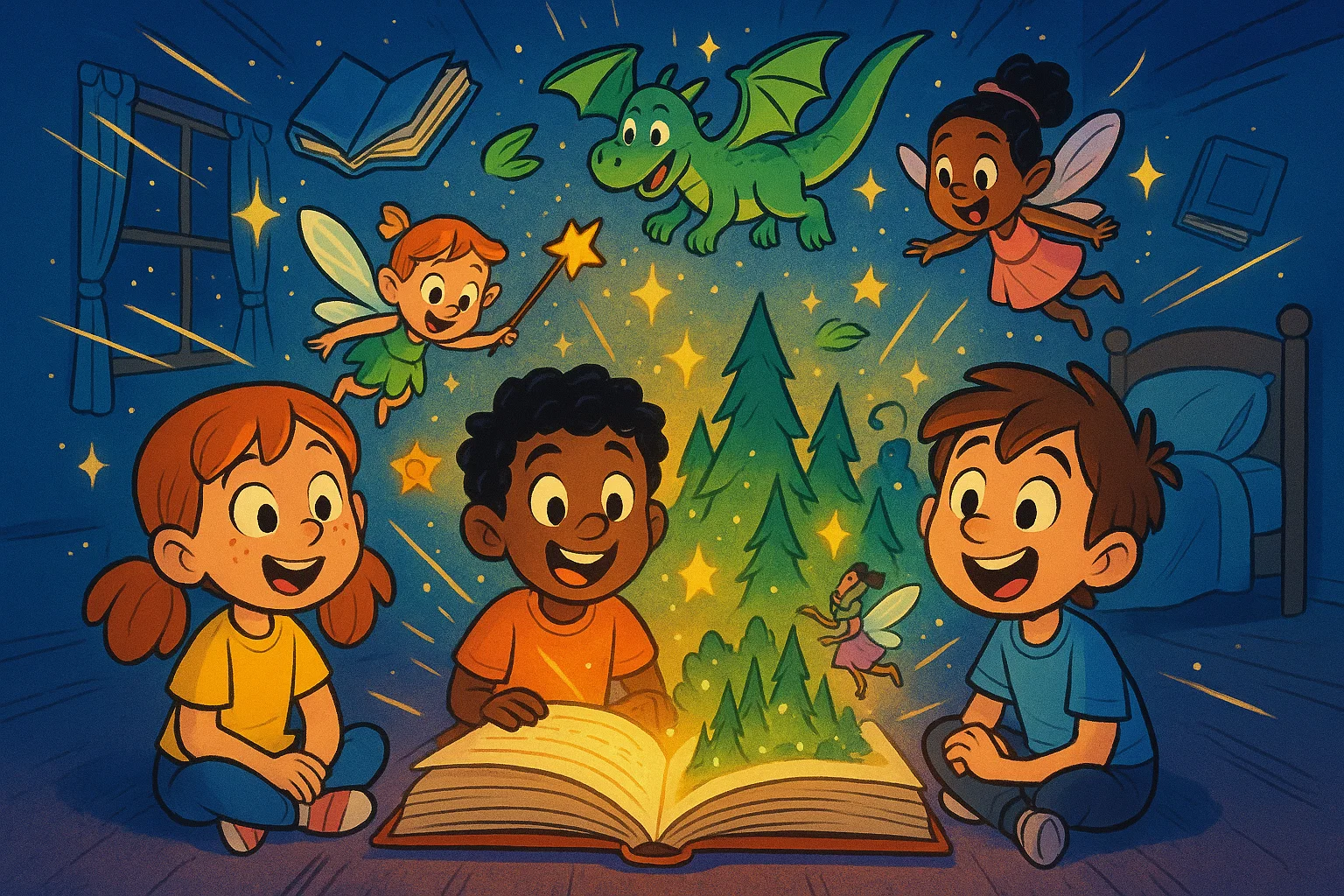
Sharing bedtime stories is one of the most cherished parts of childhood. More than a nightly routine, it opens a doorway to worlds where imagination soars and anything feels possible. Magical tales of enchanted forests, brave dreamers, and talking creatures do more than entertain — they shape young minds, nurture empathy, and strengthen the bond between parent and child.
Each time a parent begins, “Once upon a time,” a child’s creativity and moral awareness awaken. Through these gentle stories, children explore emotions, courage, and kindness in a safe, relatable way — learning to dream of castles and believe in the power of good.
Best Magic Stories for Kids
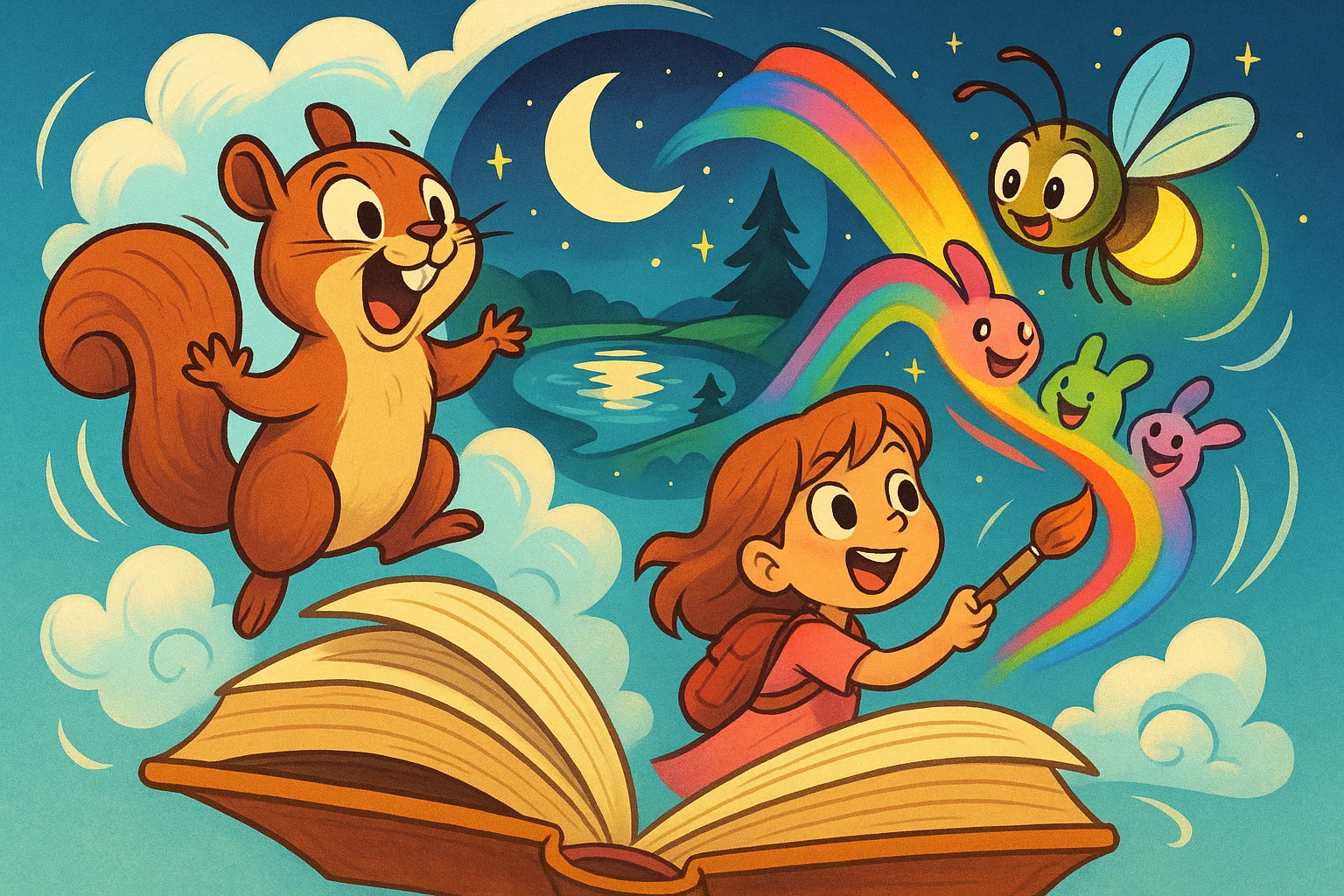
Choosing the right story can make all the difference, especially when you want to enchant your child just before they drift off to sleep. The best fairy tales and short narratives are those that combine a delightful plot with a clear moral of the story.
The Friendly Firefly
This beautiful short story often centers on a tiny firefly whose light, instead of being used for itself, is used to guide lost animals or help a struggling dreamer find their way home. It’s a wonderful tale of selflessness and empathy, demonstrating that even the smallest among us can have a huge impact. The firefly’s glowing faintly reminds children that true strength lies in helping others.
The Enchanted Lake
In this narrative, a hidden lake shimmers with starlight and is rumored to grant wishes, but only to those who approach it with a pure, kind heart. Often, the wishes granted are not for wealth or power, but for the well-being of others. The moral beautifully illustrates that genuine happiness comes from good intentions and generosity. The lake’s shimmer acts as a mirror to the child’s own kindness.
Mia and the Magic Paintbrush
Mia, a character with a love for art, discovers a storybook with a magic paintbrush that brings her drawings to life. This story is a fantastic vehicle for discussing responsibility. As her creations—be it a talking animal or an elf—step off the page, Mia must learn that her gift comes with the duty to use it wisely, not for mischief, but to sprinkle joy into her quiet village.
The Brave Little Squirrel
Set in an enchanted forest, this tale focuses on a small squirrel who must overcome its fear to save its friends from a difficult situation, perhaps a swift river or a trickster fox. It’s a classic, yet powerful, lesson in facing fears, demonstrating that bravery isn’t the absence of fear, but the decision to act despite it. The squirrel’s quick wink to its relieved friends at the end is a heartwarming payoff.
The Parrot’s Secret
A colorful parrot, a master of mimicry, learns a valuable lesson about honesty. In one version, the parrot’s ability to talk causes a misunderstanding, which is only resolved when the parrot finally tells the truth. This narrative is a simple, direct lesson on the importance of being truthful, even when it’s difficult.
Long Magical Tales for Dreamers
For older children who can sustain attention for longer, these stories offer rich plots, complex characters, and deeper moral lessons. These beloved tales often become lasting storybook favorites.
The Castle in the Clouds
This adventure follows two best friends who discover a way to a spectacular castle in the clouds. The journey is fraught with mild challenges that require them to use their unique skills and trust each other implicitly. The story focuses on the power of true friendship and cooperation, illustrating that teamwork is the real magic.
The Parliament of Talking Animals
A humorous and engaging tale where the talking animals of the forest must elect a new leader. Each animal—from the wise owl to the quick-witted rabbit—has a different idea of leadership. This story subtly explores themes of democracy, effective communication, and the value of diverse perspectives — all while maintaining a lighthearted tone.
The Invisible Cloak of Courage
A child is gifted an invisible cloak, not to hide, but to use when they feel afraid. They soon realize that the cloak’s power is not the invisibility itself, but the reminder that courage is already within them. This story is an excellent tool for helping children overcome anxieties and understand self-belief. It teaches that the magic is not in the object, but in the heart.
Worlds Beyond the Doorway
This series of adventures sees a curious child finding a series of magical doorways in their room, each leading to a different fantastical world. These journeys are a metaphor for the power of curiosity and the endless possibilities of imagination. It encourages children to be dreamers and explore new ideas.
Short Magic Stories for Quick Bedtime Reading
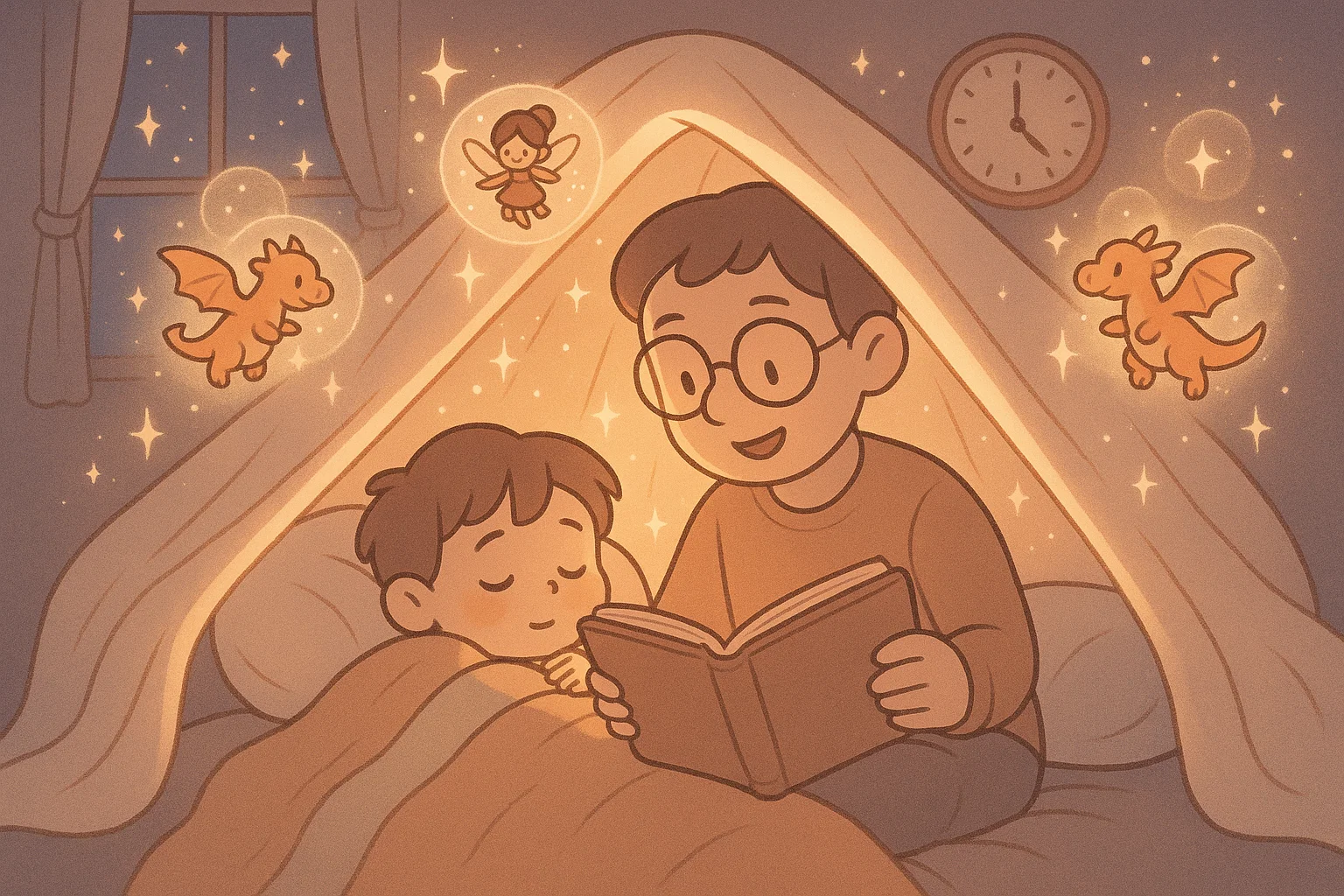
Sometimes, a parent only has a few minutes before the little ones need to sleep. These concise fairy tales are designed to deliver a dose of magic and a clear moral quickly and effectively.
| Story Title | Core Theme | Approximate Reading Time |
| The Magic Box | Kindness and Reward | 3 minutes |
| The Dragon in the Teacup | Unlikely Friendships | 4 minutes |
| The Fairy in the Paintbox | Creativity and Joy | 5 minutes |
The Magic Box
A simple narrative about a child who receives an ordinary-looking box. Every time they perform an act of kindness in their quiet village, a tiny sparkle appears in the box. Eventually, the box twinkles brightly and gives them a wonderful, simple reward, illustrating the idea that good deeds are their own reward.
The Dragon in the Teacup
A miniature, harmless dragon is found sleeping in a teacup. Initially frightening, the child soon discovers the dragon is friendly and just needs a home. It’s a sweet lesson on not judging things by appearance and the joy of forging unexpected friendships.
The Fairy in the Paintbox
A playful story of a tiny winged fairy who lives inside a child’s paintbox, making the colors extra vibrant and encouraging the child to create wonderful art. This tale promotes creativity and the idea that imagination is a vibrant, living force.
Morals in Magic Stories
The true power of stories for kids lies in their ability to teach profound life lessons through compelling narratives.
Lessons About Friendship and Teamwork
Magic stories are often built on quests and challenges that cannot be completed alone. The character’s success is frequently tied to their ability to trust and collaborate. They teach children that even the strongest hero needs a friend—or a talking animal companion—to succeed.
Courage and Self-Belief in Magical Worlds
In these stories, heroes are rarely born fearless. They often face a stormy night or a fearsome beast, and their victory is a testament to overcoming internal fear. The tales demonstrate that courage is a learned trait, and self-belief is the real magic that defeats the darkness. For instance, the small elf might be the one to save the day through cleverness, not size.
Value of Kindness and Gratitude
Kindness is almost always rewarded in fairy tales. A big-hearted character who offers help to a seemingly insignificant creature is often later repaid with unexpected stardust or assistance. This reinforces the principle that courtesy and appreciation are foundational to a good life.
Famous Magical Characters Kids Love
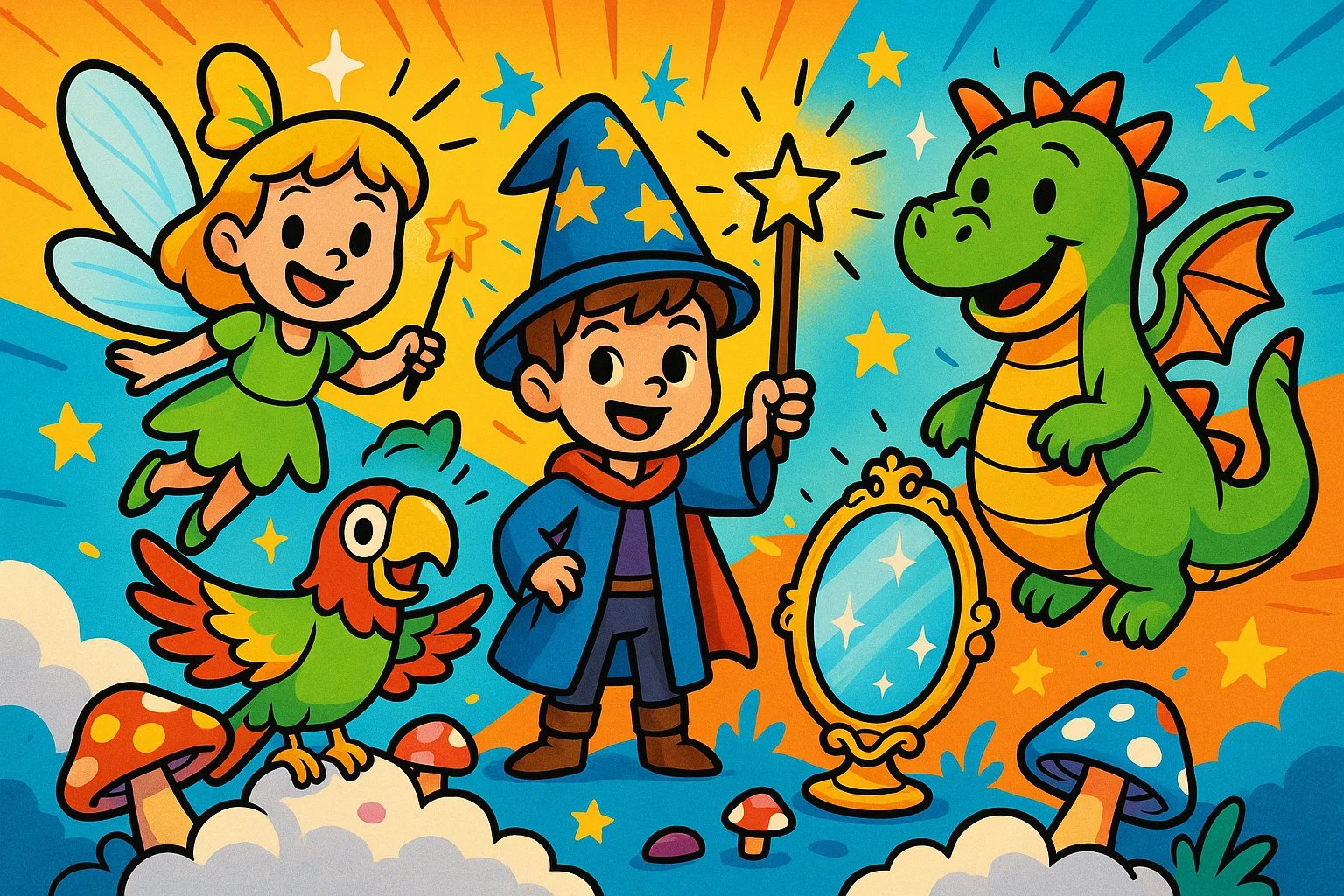
Bedtime stories are defined by the iconic characters who populate them, from the gentle to the powerful.
Fairies, Wizards, and Talking Animals
These archetypes are beloved because they represent either wish fulfillment or relatable personality traits. Fairies bring beauty and wonder, wizards embody knowledge and power, and talking animals offer companionship and humor, often acting as a mirror to human behavior. They help the little ones process the world around them.
Magical Objects and Their Power
Items like a crystal ball, a magic lamp, or the “Invisible Cloak of Courage” are metaphors for the internal power of the child. They symbolize a hidden potential waiting to be unlocked. For a child, thinking of a lantern lighting the way is like thinking of their own inner guidance.
Modern Heroes with Magical Abilities
Contemporary stories for children often feature protagonists who discover their own powers in everyday settings. This blend of reality and fantasy makes the idea of personal magic feel accessible and relevant, encouraging children to see the extraordinary in the ordinary.
How to Create Your Own Magic Story for Kids
There’s nothing quite as special as a story created just for your child, especially when you whisper it to them at bedtime.
Choosing Magical Elements and Settings
Start by choosing a familiar setting—your neighborhood, a local park, or even a small part of your home—and add something magical. Maybe the old oak in the park is where an elf lives, or the light switch twinkles with stardust. The goal is to make the ordinary extraordinary.
Writing Characters with Emotion and Purpose
Base your protagonist on your child, giving them a big heart or an inquisitive nature. Introduce a magical companion, perhaps a whimsical creature or a talking animal friend, to act as a sidekick and guide. Giving characters clear motivations and emotions makes them relatable.
Adding a Moral or Lesson Naturally
The moral of the story shouldn’t be tacked on at the end, but woven into the plot. If you want to teach patience, the magical item might appear only after the character waits quietly, watching the firefly’s gentle glow instead of rushing impatiently.
Reading Tips for Parents and Teachers
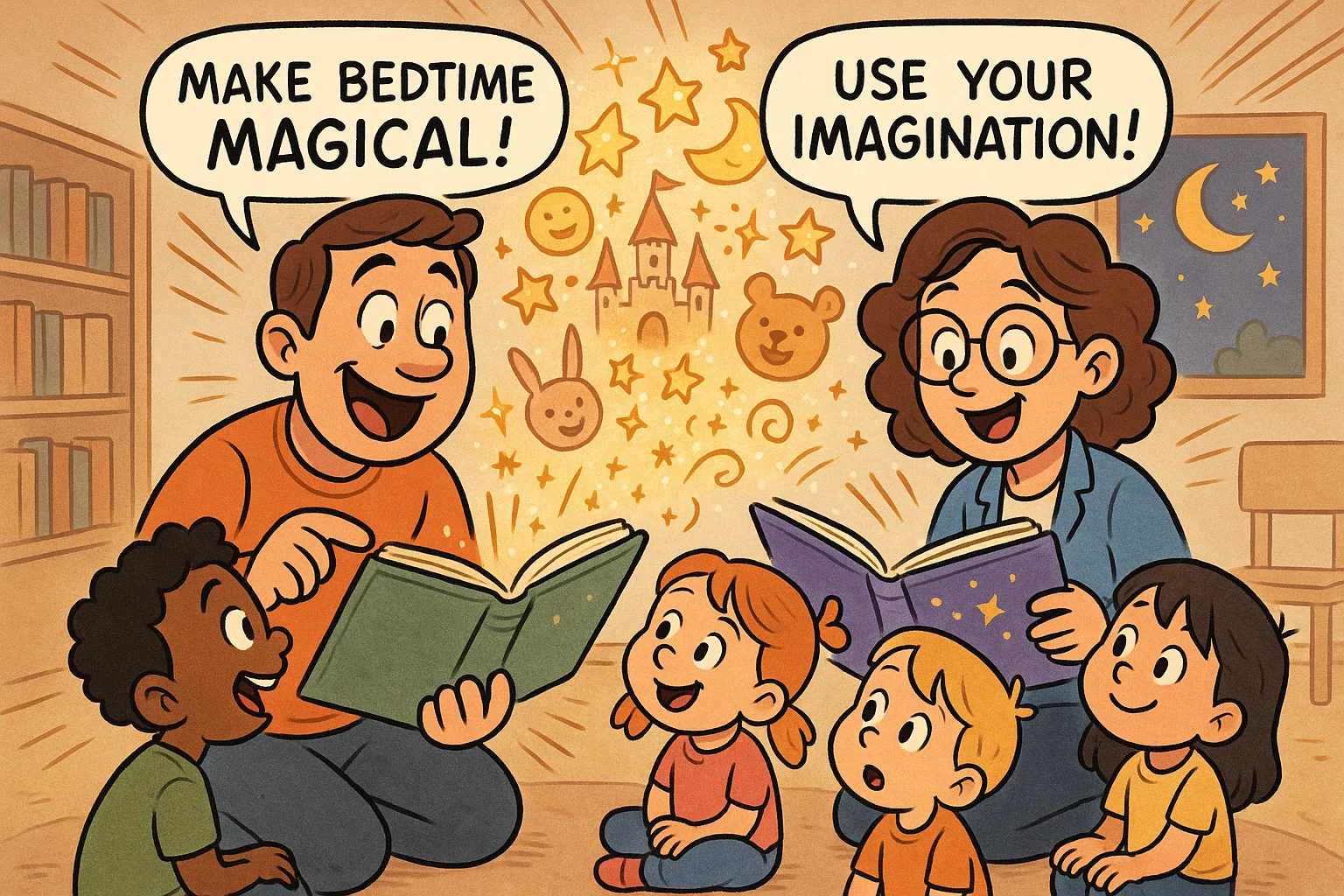
To truly enchant your listener and make bedtime stories as effective as possible, the delivery is key.
Making Bedtime Magical
- Establish a Routine: A consistent time and place signals to the child that it is time to unwind.
- Set the Scene: Dim the lights, use a small, soft lamp (like a gentle lantern), and sit close. The quiet, intimate atmosphere is naturally conducive to calm.
- Vary Your Voice: Use different tones and whisper when appropriate to bring the characters and the setting to life. A well-placed lullaby can transition the child to sleep.
Encouraging Discussion After Reading
Don’t let the story end when you close the storybook. Ask open-ended questions:
- “How did the little elf feel when they were scared?” (Emotional awareness)
- “What did you learn from the talking animals today?” (Moral understanding)
- “If you had something magical, how would you use it?” (Critical thinking and creativity)
Turning Stories into Activities
Extend the magic beyond the bedtime routine:
- Story Art: Encourage drawing a scene or character from the story.
- Imaginative Play: Use the story as a basis for pretend play, where your child can be the brave hero or the whimsical fairy.
- Nature Walks: Go on a “treasure hunt” in the park, searching for signs of the enchanted forest or the magical creatures.
Conclusion: Why Magic Stories for Kids Matter
The tradition of sharing magical bedtime stories for kids is an investment in a child’s whole development. These are not merely tales of fantasy; they are narratives that build essential values, from kindness and courage to the importance of gratitude. By immersing little ones in a world where stardust can sprinkle miracles, you are nurturing their imagination and teaching them how to process the complexities of the real world. The shared experience of reading books and telling stories strengthens your emotional connection, promotes language skills, and develops the cognitive ability to grasp abstract concepts. Moral lessons are absorbed easily and naturally when delivered through the engaging vehicle of a fairy tale. Every night can become something magical if you simply open a storybook and begin with ‘Once upon a time…’.
FAQs on Magic Stories for Kids
What age group enjoys magic stories most?
Magic stories and fairy tales are perfect for children across all age groups, though their complexity should be adjusted. Toddlers (ages 2-4) enjoy simple plots, repetition, and whimsical characters like a friendly firefly or simple talking animals. Older children (ages 5-8 and up) thrive on more detailed adventures, deeper moral dilemmas, and rich world-building, such as the quests to a castle in the clouds.
Are magic stories good for bedtime reading?
Yes, absolutely. Magical bedtime stories are excellent for preparing children for sleep. The fantastical elements, often paired with a soothing, predictable structure, help the child’s mind transition from the day’s excitement to a calm, restful state. The soft whisper and rhythmic tone can be as effective as a lullaby, encouraging them to dream of castles and peace.
How do magic stories help in moral development?
Magic stories provide a clear framework for ethical concepts. The battles between good and evil, the rewarding of a big heart, and the consequences of selfish actions offer concrete, safe examples for children to understand morality. When a hero with a big heart defeats a villain, the story powerfully conveys lessons about kindness and fairness.
Can kids write their own magic stories?
Encouraging children to tell stories and write their own is a wonderful way to develop creativity and literacy. Give them prompts—like a magical object (a lantern or a shimmering stone) or a character (an elf or a friendly monster). This simple act boosts their confidence and cognitive skills.
What is the best length for a bedtime story?
The optimal duration depends heavily on the child’s age and temperament. For toddlers, 3-5 minutes is ideal to maintain their attention. For older preschoolers (4-6), 5-10 minutes is usually sufficient. School-aged children can easily enjoy stories lasting 10-15 minutes or longer chapters from a beloved storybook. The key is to stop while they are still engaged, leaving them relaxed but curious.
